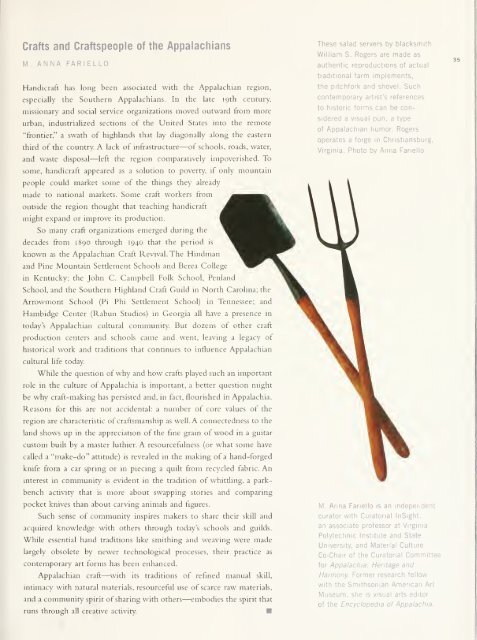SCOTLAND - Smithsonian Digital Repository - Smithsonian Institution
SCOTLAND - Smithsonian Digital Repository - Smithsonian Institution
SCOTLAND - Smithsonian Digital Repository - Smithsonian Institution
You also want an ePaper? Increase the reach of your titles
YUMPU automatically turns print PDFs into web optimized ePapers that Google loves.
Crafts and Craftspeople of the Appalachians<br />
M. ANNA FARIELLO<br />
Handicraft has long been associated with the Appalachian region,<br />
especially the Southern Appalachians. In the late 19th century,<br />
missionary and social service organizations moved outward from more<br />
urban, industrialized sections of the United States into the remote<br />
"frontier," a swath of highlands that lay diagonally along the eastern<br />
third of the country. A lack of infrastructure—of schools, roads, water,<br />
and waste disposal—left the region comparatively impoverished. To<br />
some, handicraft appeared as a solution to poverty, if only mountain<br />
people could market some of the things they already<br />
made to national markets. Some craft workers from<br />
These salad servers by blacksmith<br />
William S. Rogers are made as<br />
authentic reproductions of actual<br />
traditional farm implements,<br />
the pitchfork and shovel. Such<br />
contemporary artist's references<br />
to historic forms can be considered<br />
a visual pun, a type<br />
of Appalachian humor. Rogers<br />
operates a forge in Christiansburg,<br />
Virginia. Photo by Anna Fariello<br />
35<br />
outside<br />
the region thought that teaching handicraft<br />
might expand or improve its production.<br />
So many craft organizations emerged during the<br />
decades from 1890 through 1940 that the period is<br />
known as the Appalachian Craft Revival. The Hindman<br />
and Pine Mountain Settlement Schools and Berea College<br />
in Kentucky; the John C. CampbeU Folk School, Penland<br />
School, and the Southern Highland Craft Guild in North Carohna; the<br />
Arrowmont School (Pi Phi Settlement School) m Tennessee; and<br />
Hambidge Center (Rabun Studios) in Georgia all have a presence in<br />
today's Appalachian cultural community. But dozens of other craft<br />
production centers and schools came and went, leaving a legacy ot<br />
historical work and traditions that continues to influence Appalachian<br />
cultural life<br />
today.<br />
While the question of why and how crafts played such an important<br />
role in the culture of Appalachia is important, a better question might<br />
be why craft-making has persisted and, in fact, flourished m Appalachia.<br />
Reasons for this are not accidental: a number of core values of the<br />
region are characteristic of craftsmanship as well. A connectedness to the<br />
land shows up in the appreciation of the fine grain of wood in a guitar<br />
custom built by a master luthier. A resourcefulness (or what some have<br />
called a "make-do" attitude) is revealed in the making of a hand-forged<br />
knife from a car spring or in piecing a quilt from recycled fabric. An<br />
interest in community is evident in the tradition of whittling, a parkbench<br />
activity that is more about swapping stories and comparing<br />
pocket knives than about carving animals and figures.<br />
Such sense of community inspires makers to share their skill and<br />
acquired knowledge with others through today's schools and guilds.<br />
While essential hand traditions like smithing and weaving were made<br />
largely obsolete by newer technological processes, their practice as<br />
contemporary art forms has been enhanced.<br />
Appalachian craft—with its traditions of refined manual skill,<br />
intimacy with natural materials, resourceful use of scarce raw materials,<br />
and a community spirit of sharing with others—embodies the spirit that<br />
runs through all<br />
creative activity.<br />
M. Anna Fariello is an independent<br />
curator with Curatorial<br />
InSight,<br />
an associate professor at Virginia<br />
Polytechnic Institute and State<br />
University, and Material Culture<br />
Co-Chair of the Curatorial Committee<br />
for Appalachia: Heritage and<br />
Harmony. Former research fellow/<br />
w/ith the <strong>Smithsonian</strong> American Art<br />
Museum, she is<br />
visual arts editor<br />
of the Encyclopedia of Appalachia.
















